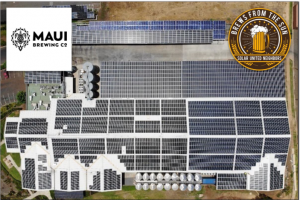In This Issue
- Flanigan’s EcoLogic: The American Offshore Wind Race
- Oil Rigs to Reefs!
- General Electric Gas Plant Closure
- Lightyear One’s 450 Miles of Range
- Solar Booming in Florida!
- Dubai’s 900 MW Solar Tender
- Solar Brew Pubs Celebrated
- New York City Declares Climate Emergency
- The TWA Hotel at JFK
- Japan’s Virtual Power Plant
- EcoMotion Update: Residential Solar Workshop in Carson

Flanigan’s EcoLogic: The American Offshore Wind Race
RenewableUK reports that the global offshore wind market grew by 16% over the last 12 months. It’s all about bigger and better technology. Wind turbines being employed on new projects generate three times the power of turbines just five years ago.
Globally, offshore wind in operation, under construction, or in development rose from 105,000 MW to 121,000 MW. China has 12,000 MW in the pipeline; Taiwan 8,900 MW. In the North Sea off the United Kingdom, the world’s biggest offshore wind farm just came on line. Located 75 miles offshore, its turbines anchored to the sea floor, Hornsea One has a generating capacity of 1,200 MW, pushing the U.K.’s offshore wind generating capacity to 8,200 MW, the largest in Europe.
While the United States has only 30 MW of offshore wind installed, the United States now accounts for nearly half of the rapid global growth reported by RenewableUK. The U.S. has wind farms planned in Massachusetts (with a goal of 1,600 MW), Rhode Island, Connecticut, New York, and Maryland. There’s a race being run between these states given wind potential to develop 20,000 MW of offshore wind on the East Coast by 2030, representing a $70 billion business opportunity according to research at the University of Delaware.
In April, Massachusetts approved its first offshore contracts for 800 MW; New York is concurrently working to procure 800 MW or more. On July 1st the Connecticut Department of Energy and Environmental Protection (DEEP) issued a draft Request for Proposals to procure up to 2,000 MW of offshore wind capacity to begin delivery no later than 2026.
The largest offshore wind procurement in the U.S. just took place in New Jersey. The Garden State selected Denmark’s Orsted A/S to develop a 1,100 MW wind project off the coast of Atlantic City. The New Jersey Board of Public Utilities (BPU) reviewed a number of proposals including one presented by Equinor from Norway and a joint venture between EDF Renewables North America and Shell New Energies. The BPU cited experience as a determining factor; Orsted bought offshore wind developer Deepwater Wind last year.
“New Jersey is going to be finally open for business as far as offshore wind is concerned,” said BPU President Joseph Fiordaliso. This project is the first step in the State’s commitment to contract for 3,500 MW of offshore wind by 2030. The project is called Ocean Wind, will create 15,000 jobs, and is expected to be completed in 2024.

 Could California’s offshore oil rigs find new life as underwater reefs? Two University of California Santa Barbara professors are finding that reefing the habitat under decommissioned oil and gas platforms could well be beneficial for California and its coastal biodiversity.
Could California’s offshore oil rigs find new life as underwater reefs? Two University of California Santa Barbara professors are finding that reefing the habitat under decommissioned oil and gas platforms could well be beneficial for California and its coastal biodiversity. General Electric announced in June that it will demolish its 750 MW Inland Empire Energy Center in Sun City, California this year after only one-third of its useful life. GE stated that the plant is no longer economically viable where wind and solar supply a growing share of the State’s inexpensive electricity. The closure illustrates stiff competition in the deregulated energy market. Cheap renewables are squeezing out fossil fuels.
General Electric announced in June that it will demolish its 750 MW Inland Empire Energy Center in Sun City, California this year after only one-third of its useful life. GE stated that the plant is no longer economically viable where wind and solar supply a growing share of the State’s inexpensive electricity. The closure illustrates stiff competition in the deregulated energy market. Cheap renewables are squeezing out fossil fuels. Lightyear has unveiled the first prototype of the Lightyear One, an EV covered in solar panels that it plans to start selling in 2021. Pundits say that it has an “eye-watering price,” a cool $135,000 to reserve one and $170,000 to buy one. Lightyear was founded in 2016 by Solar Team Eindhoven from the Netherlands, a team of engineering students who won the solar power World Solar Challenge race in 2013, 2015, and 2017. Their cars, named “Stella” were loaded with solar that produced more power than they consumed, meaning that you could end a journey with more charge than when you started!
Lightyear has unveiled the first prototype of the Lightyear One, an EV covered in solar panels that it plans to start selling in 2021. Pundits say that it has an “eye-watering price,” a cool $135,000 to reserve one and $170,000 to buy one. Lightyear was founded in 2016 by Solar Team Eindhoven from the Netherlands, a team of engineering students who won the solar power World Solar Challenge race in 2013, 2015, and 2017. Their cars, named “Stella” were loaded with solar that produced more power than they consumed, meaning that you could end a journey with more charge than when you started! For many years Florida’s solar policies have lagged behind other states: Sadly, the Sunshine State has no renewable portfolio standard and does not allow power purchase agreements, two policies that have driven investments in solar in other states. Now thanks to recent developments and low PV prices, significant growth is on the horizon, and Florida ranks second for projected capacity installed over the next five years, with nearly 5.5 GW expected to come on line. NREL researchers foresee Florida’s solar power penetrations climbing as high as 30% over the next ten years, up from a tenth of a percent in 2015. Duke power is planning a 700 MW solar farm in Florida; Florida Power and Light plans to build 4,000 MW of solar over the next decade.
For many years Florida’s solar policies have lagged behind other states: Sadly, the Sunshine State has no renewable portfolio standard and does not allow power purchase agreements, two policies that have driven investments in solar in other states. Now thanks to recent developments and low PV prices, significant growth is on the horizon, and Florida ranks second for projected capacity installed over the next five years, with nearly 5.5 GW expected to come on line. NREL researchers foresee Florida’s solar power penetrations climbing as high as 30% over the next ten years, up from a tenth of a percent in 2015. Duke power is planning a 700 MW solar farm in Florida; Florida Power and Light plans to build 4,000 MW of solar over the next decade. The next and fifth phase of the Mohammed bin Rashid Al Maktoum Solar Park located 30 miles south of Dubai in the United Arab Emirates has attracted huge interest. Fully 64 companies will submit their final bids for a total of 900 MW by August 22 of this year. The winning companies will take 40% interests in their projects, the balance will be owned by the Dubai Electricity and Water Authority (DEWA).
The next and fifth phase of the Mohammed bin Rashid Al Maktoum Solar Park located 30 miles south of Dubai in the United Arab Emirates has attracted huge interest. Fully 64 companies will submit their final bids for a total of 900 MW by August 22 of this year. The winning companies will take 40% interests in their projects, the balance will be owned by the Dubai Electricity and Water Authority (DEWA). Solar United Neighbors, a 501c3 based in Washington DC, now hosts an annual competition to crown America’s favorite craft breweries that have gone solar. The concept behind the competition is to bring together craft beer lovers and solar energy supporters. So far, Solar United Neighbors is recognizing 137 that breweries have gone solar, from Alaska to Missouri, Vermont to Hawaii! This year’s winners were elected by 12,334 people weighing in on 44 breweries that competed across three categories.
Solar United Neighbors, a 501c3 based in Washington DC, now hosts an annual competition to crown America’s favorite craft breweries that have gone solar. The concept behind the competition is to bring together craft beer lovers and solar energy supporters. So far, Solar United Neighbors is recognizing 137 that breweries have gone solar, from Alaska to Missouri, Vermont to Hawaii! This year’s winners were elected by 12,334 people weighing in on 44 breweries that competed across three categories. Power in numbers: More than 670 governments in 15 countries have formally declared “Climate Emergencies” according to the Cool Earth Forum. Eighteen of these are American, but now New York City, America’s largest city with 8.62 million inhabitants, is the largest city on Earth to declare such an emergency. These governments are calling for immediate response to global climate crises. New York’s declaration cites extreme temperatures that will be, “too hot to be a safe environment.” The City and its residents, “bear an extraordinary responsibility to address these existential threats.” New York joins Dublin, Geneva, and Sydney.
Power in numbers: More than 670 governments in 15 countries have formally declared “Climate Emergencies” according to the Cool Earth Forum. Eighteen of these are American, but now New York City, America’s largest city with 8.62 million inhabitants, is the largest city on Earth to declare such an emergency. These governments are calling for immediate response to global climate crises. New York’s declaration cites extreme temperatures that will be, “too hot to be a safe environment.” The City and its residents, “bear an extraordinary responsibility to address these existential threats.” New York joins Dublin, Geneva, and Sydney. For many of us who grew up in New York and for whom JFK has been our base airport (after “Idlewild” that is), the Trans World Airways (TWA) terminal is a lasting impression. The “flight center’s” bold architecture set it far apart from all other terminals. The original building was designed in 1962 by the Finnish America architect Eero Saarinen. In 1991 TWA was sold to American Airlines parent company. At that time there were proposals to repurpose the site of the TWA terminal. Then in 1994, it was deemed a landmark by the New York City Landmarks Preservation Commission. That prevented its demolition.
For many of us who grew up in New York and for whom JFK has been our base airport (after “Idlewild” that is), the Trans World Airways (TWA) terminal is a lasting impression. The “flight center’s” bold architecture set it far apart from all other terminals. The original building was designed in 1962 by the Finnish America architect Eero Saarinen. In 1991 TWA was sold to American Airlines parent company. At that time there were proposals to repurpose the site of the TWA terminal. Then in 1994, it was deemed a landmark by the New York City Landmarks Preservation Commission. That prevented its demolition. Japan’s virtual power plant – the AutoGrid-ENERES VPP — fulfills the function of a traditional central power station, but its operations are highly distributed. And in this case, the distributed power plant’s assets are “behind the meter,” meaning its distributed elements are on customers’ premises. According to the California company developing the project, Autogrid, the project is being described as the world’s largest behind-the-meter, microgrid virtual power plant (VPP). Schneider Electric recently bought a stake in Autogrid.
Japan’s virtual power plant – the AutoGrid-ENERES VPP — fulfills the function of a traditional central power station, but its operations are highly distributed. And in this case, the distributed power plant’s assets are “behind the meter,” meaning its distributed elements are on customers’ premises. According to the California company developing the project, Autogrid, the project is being described as the world’s largest behind-the-meter, microgrid virtual power plant (VPP). Schneider Electric recently bought a stake in Autogrid. “Residential Solar in Carson” was the topic in focus last night at the Carson Community Center. Arranged by the SBCCOG and the City of Carson, and supported by the SolSmart and The Solar Foundation, the July 9th evening workshop provided South Bay residents with information about the benefits, challenges and opportunities of going solar. Carson’s Reata Kulcsar welcomed the group assembled. Many came early and were eager to learn. Ted Flanigan introduced EcoMotion and its solar consulting services, emphasizing that “we are not in the business of selling anything. Instead, our corporate mission is to help homeowners, businesses, and institutions of all kinds get the best quality, cost-effective solar solutions.” Solar Specialists Shaun Miller and Michael Ware then presented a comprehensive slide deck — Solar 101 – that covered solar basics, storage, EV integration, financing, how to advance your solar interest, plus contact information and links to key websites and solar resources. Shaun and Michael then fielded numerous questions from the homeowners assembled; some stayed on to get personalized insights. Several workshop participants commented that they’d heard so many pitches – like “no-cost solar” – that they found the workshop and EcoMotion’s objective remarks refreshing and useful. They can follow up with the City of Carson for support. Participants now have a basic understanding, a bit of inspiration and encouragement, and a set of resources to help them go solar.
“Residential Solar in Carson” was the topic in focus last night at the Carson Community Center. Arranged by the SBCCOG and the City of Carson, and supported by the SolSmart and The Solar Foundation, the July 9th evening workshop provided South Bay residents with information about the benefits, challenges and opportunities of going solar. Carson’s Reata Kulcsar welcomed the group assembled. Many came early and were eager to learn. Ted Flanigan introduced EcoMotion and its solar consulting services, emphasizing that “we are not in the business of selling anything. Instead, our corporate mission is to help homeowners, businesses, and institutions of all kinds get the best quality, cost-effective solar solutions.” Solar Specialists Shaun Miller and Michael Ware then presented a comprehensive slide deck — Solar 101 – that covered solar basics, storage, EV integration, financing, how to advance your solar interest, plus contact information and links to key websites and solar resources. Shaun and Michael then fielded numerous questions from the homeowners assembled; some stayed on to get personalized insights. Several workshop participants commented that they’d heard so many pitches – like “no-cost solar” – that they found the workshop and EcoMotion’s objective remarks refreshing and useful. They can follow up with the City of Carson for support. Participants now have a basic understanding, a bit of inspiration and encouragement, and a set of resources to help them go solar.